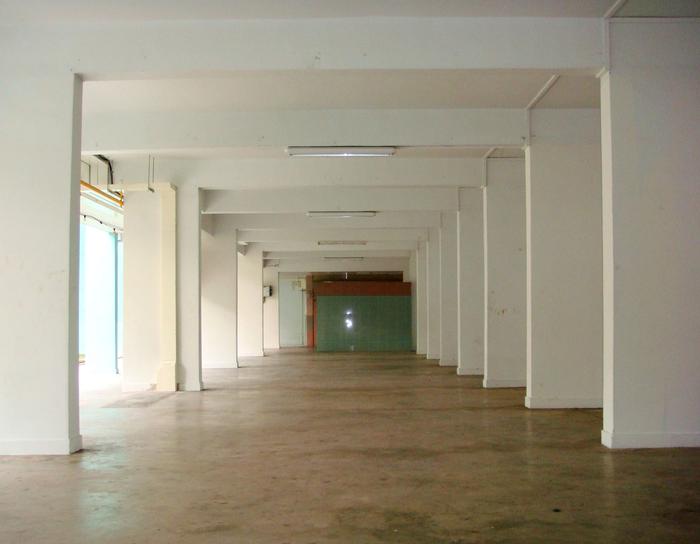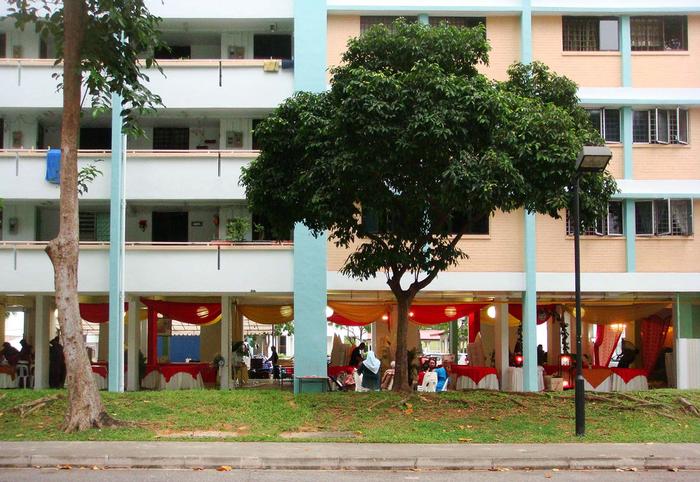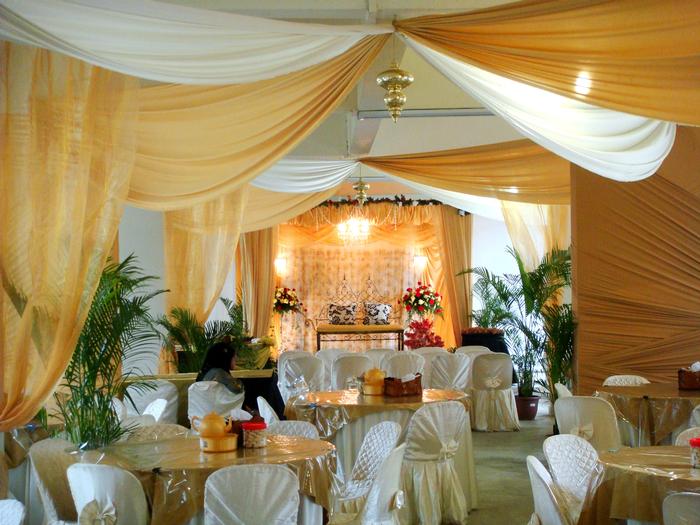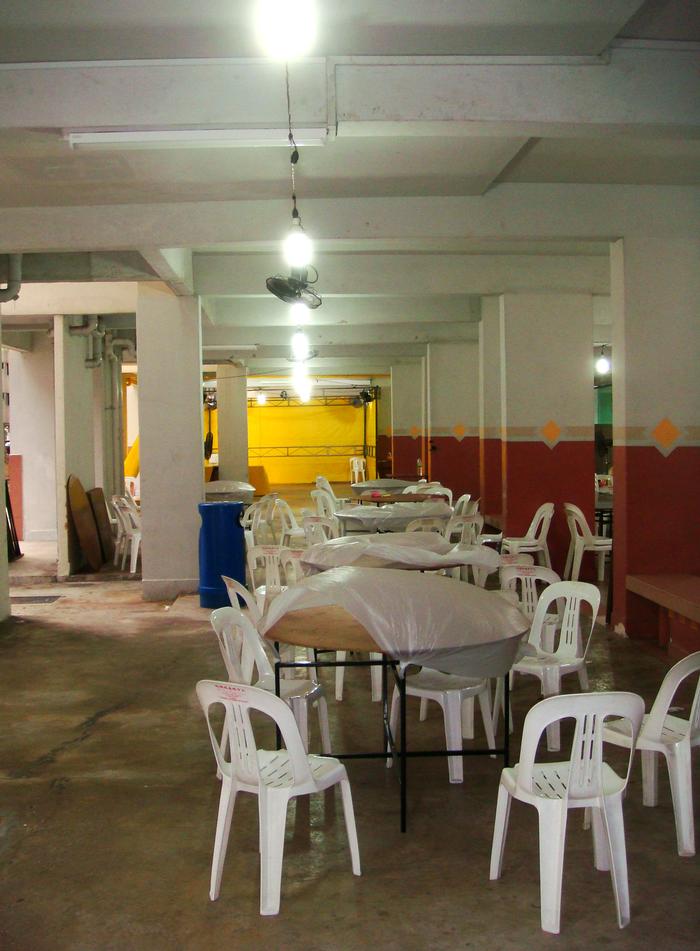[ID:73] Supernormal of the void deckSingapore “It is only with the heart that one can see rightly; what is essential is invisible to the eye” --- Antoine de Saint-Exupery
This quote conveys what we think is a sacred space. It may not be grand, neither must it be spectacular, but it certainly has to touch the heart, and inspire the soul. Rather than focusing on a unique or distinctive architecture, we have chosen a space that expresses normality, one that people are so familiar with, that it has blended comfortably into their lives.
80% of Singaporeans live in high rise buildings, known as HDB flats. Within one roof, residents occupy all levels except the ground floor, commonly known as the void deck. It is an open public space, without a particular program; a stone table with benches is sufficed to describe this void.
“What significance can there be in an empty space? There is nothing in here. ”
Despite the fact that the void deck is deprived of any particular use, it should not be rendered useless. On the contrary, void should be thought of as the fruitful starting point of everything, and the void deck exemplifies a place of potentiality.
The void deck in HDB flat was first implemented as a spatial strategy to reconcile cosmopolitan individualism with heartland collectivity since 1970s. Even though the design of the HDB has altered considerably over the years, this concept has continued to manifest through the void deck’s programmatic flexibility and permissiveness. The blank walls, floor and fixtures beyond the structural elements, together with the stone tables and chairs, create pervasive openness that encourages the multitude of events. Through the years, the void deck has been providing a platform for everyday activities as well as a stage for social and cultural events.
After their routine morning visits to the wet market, housewives tend to congregate around the stone tables, trading gossips or making casual remarks about favourite drama serials shown on the previous night. Hardworking students use it as a space for their homework revision. The elderly sit like sages, deploying chess pieces on the stone table with unspoken tension and intense concentration, executing strategies unfathomable to curious onlookers. The silence is in clear juxtaposition to the vivacious atmosphere created by children chasing each other around the void deck who use the columns as defence against their pursuers. On a sudden thunderstorm, the incidental passerby could run in for shelter. Or it could just be a path that residents from neighbouring blocks wander through. There is no specific function or activity that the void deck is known for. Anyone could walk freely through these spaces without hesitation or fear.
Whether personal or collective, meaningful or insignificant, the void deck inscribes events like a diary, documenting the life of a community meticulously and unconditionally. Amid the recorded events, there are pages of unforgettable occasions, often relating to the individual’s participation and experience in the void deck space.
To us, sacredness is not here to stay—-this quality does not reside perpetually in a building. Most of the time, the void deck remains latent. Yet, sacredness can be induced in the void deck when the moment arises. The monotony and lack of character disappears when it becomes the setting for special events. Transformation transpires, metamorphosing the void deck, from a neutral space, into a symbolic entity. Thus, it is the intense interplay and vigorous negotiation of both the architecture and event that shed light to the meaning of sacred. Synthesis of the physical object and the human subject gives meaning to a space, hence suggesting what sacred architecture might be. It could serve the immeasurable, paying tribute to a particular dimension that encompasses dreams, memories and experience. It may be the aspiration of the young boy, Hafiz, who started playing soccer, or the hope and anxieties of a newly wed Malay couple, or the sorrows of the family dealing with the inexorable death of a beloved kin. All three events seem arbitrary, yet all of them occur in the humble setting of the void deck.
The void deck is one of the favourite hangouts for youths, just like Hafiz. Using slippers and shoes for goal posts, together with structural columns that act as artificial opponents, the big empty space becomes their chosen location to display their soccer skills. Children from the estate would turn up at the void deck at the same time unanimously, forging strong camaraderie amongst them overtime. Perhaps only a few will continue their passion and mature to be professional sportsmen, but more will cherish the time spent together with childhood friends. Each day that passed might seem ordinary, but as one views the timeframe collectively, the void deck sets the stage for interaction. The intertwining of experiences, memories and dreams crystallize everyday's monotony into precious friendships and aspirations, thus making such a place special, sacred. Over the years, the faint soccer ball stains imprinted onto the columns indicate traces of human presence that express the interface between self-awareness and place.
For the Malay community, their wedding ceremonies are often held at the void deck. Malay weddings involve the entire family, distant relatives and neighbours for the ceremony’s preparations in the spirit of community that could be traced back to their village tradition. A few hours’ work is suffice to transform the usual empty space into an exquisitely decorated area, with the cement floors carpeted and the walls draped with long cloth and colourful flowers. A space that is originally homogenous begins to speak of a hierarchy—a ‘pelamin’ (throne) is set up, facing the rows of tables that fills the void, awaiting honoured guests to witness the sacred event. Served and servant spaces become apparent, with the cooking and dish-washing facilities lined at the periphery of the void deck. Since kampung days, the Malays have been known for the 'Semangat Bergotong-Royong'—the spirit of helping one another. The void deck undergoes a fleeting transformation, allowing them to indulge in such hospitality, bringing back the identity of a community. Relatives and friends gather in the void deck, showering their blessings onto the groom and bride. Everyone arrives well-dressed with smiles on their faces. The void deck, once so unassuming and latent, takes on an exuberant character, one that is accompanied by the traditional Malay drums, with a distinctive rhythm that could be heard several blocks away, as if welcoming the neighbourhood to witness this joyous event. The informal space that originally resided here is being infused by this life-changing event.
When our loved ones depart, we wish they could transit smoothly to the other realm. Within the Chinese Buddhist and Taoist community, they believe that the spirit of the deceased could linger around the family before their departure into the transcendent reality. It is for this reason that the rituals of Chinese funerals are conducted downstairs, a space that is near to home, familiar to the deceased, and it spans over three to five days. Again, the temporal setting of the funeral wake in the void deck creates levels of rupture in the mundane world.
Whenever a void deck is surrounded by canvas, one is informed that someone living in the block has passed away. A tented enclosure set up hides the coffin from view. Throughout the next few days, family members partake themselves of the different rituals, as a form of reverence to their beloved one.
During the wake in the void deck, family members perform specific rituals, in bid to express their filial piety and pay tribute to the deceased. Participation in these rituals establishes a connection that mediates between the mortal and divine world, bridging what seemed to be too big a gap. Sequentially, one holds the incense, kneels and prays before the altar, and walks around the coffin. The bodily motion around the altar invokes a sense of journey, suggesting the connection and communication with the cosmos, as if one is accompanying the deceased for the final departure. These traditions and beliefs might seem superstitious and meaningless, yet in such moments of immense grief, the proximity of the void deck provides the setting for a period of transition. It allows one to transcend from an actual physical space into the intangible realm of the soul and mind.
Drawing parallel to the study done by Suzanne Preston Blier regarding Tamberma houses of northern Togo in West Africa, we can further envisage how a modest setting can craft out the conditions for a sacred architecture. There, the houses are designed to serve both the functional requirements of a residential unit and as stages for their various significant public and private events, with emphasis on funeral processions. Correspondingly, the spatial configurations and the construction elements are designed with the eventual dramas in mind.
Comparing the Tamberma houses and HDB residential units, we can draw certain similarities. For both, the events that are played out coincide with significant episodes of a person’s life, focusing on the relationship between human life and architecture. Yet, the central stage of events occurs within the private abode of Tamberma houses while the drama unfold outside HDB residential units, involving the use of void deck as the communal stage. This explains why participants get a mix of personal and collective experience when they reflect upon their enactment in the ritualistic events that occur in the void deck. As discussed, the ubiquitous permissiveness of the void deck allowed us to reach into our personal realms of consciousness. Its unique spatial strategy encouraged a variety of uses that in turn transform the void deck into a temporary gateway to our deepest needs. The reciprocal relationship between void deck and the individual generates highly personalised connotation towards sacredness. But yet at the same time, it belongs to the public sphere, where the community acknowledge that this is a common space. Shared memories of the group will take precedence over the individual’s association of the space, justifying itself as a form of social space.
However, in today’s context, the sacred quality in void deck is being compromised. In order to overcome the challenge of land scarcity, and still fulfil her policy of public housing for her increasing population, it seems rational for the authority to build smaller HDB units, which results in the latest configurations of HDB flats standing on reduced plots of land. Subsequently, it suggests hints of a constrained void deck, since it follows the dimensions of the allocated HDB plot. In addition, other uses such as car parks are infringing closer onto the periphery of the void deck compared to older estates. Thus, there is a need to increase awareness, so that the void deck does not get reduced purely into a transitional space.
The void deck is seen as an extension of the residential units, not just in terms of utility but also structurally. Focused on providing quality housing for all, the organisation of the columns is driven by the design of interior spaces of the residential units, such that the columns run continually through the void deck and the residential unit. During our nation building years, HDB adopted the arrangement of the columns in the void deck in the form of a grid system, which is easy to build and serves ideally from the structural point of view. The design of the columns of the HDB flats that stand on existing housing blocks measures 250mm in width(unchanged), and extend inwards (varied), depending on the amount of load they have to carry. This module of columns sits in regular intervals, spanning three metres apart, supporting the immense load from the subsequent levels above. Such composition seems to earn unanimity amongst the country’s town planners, since the same construction method is being duplicated in almost every part of Singapore.
Safe and cost-effective public housings may be the priority then, but we have progressed. It should do more than simply ensuring the affordability of the public housing. The authority should re-examine the issue in its totality—both the quantity and the quality of the living space. Besides the top-down approach, the bottom-up strategy can also be looked into. Feedbacks from users are equally as important as to how the space is perceived initially. Perhaps public housing can be designed in a way that it is not only well-crafted in the physical living space, but also speaks of sensitivity and sensibility towards the sacredness.
Can there be another way of creating space inside the void deck? Perhaps different configurations can be explored, resulting in unexpected outcomes. Maybe the columns could be lined around the periphery of the housing block, thus creating an uninterrupted void at the core of the void deck, which will then increase its options in terms of its transformation. We do realize that these proposed ideas would be extremely costly and time consuming. However, it is important to remember that a large percentage of the population lives in this house typology, and that it is only right that a fair amount of rigor and attention has been assigned to it.
The true impact of the void deck as a sacred space is best demonstrated in the following excerpt, as stated by Prime Minister Mr Lee Hsien Loong, during the National Day Rally 2009: “A Chinese grandmother died. The family decided to hold wake at the void deck of the next block. But without waiting for approval from the town council to hold their wake there, they proceeded to set up their wake. Coincidentally, that void deck had already been booked by a Malay family for a wedding. The invitations had been sent out. Now they discovered their wedding location had been snatched by another party. The Malay family of course felt very unhappy. The town council staff attempted to resolve the matter by asking the Chinese family to relocate their wake to another void deck. But the Chinese family was unwilling to accommodate. They felt that even though the coffin had not arrived, the wake had already been set up and tearing it down will bring bad luck. …a problem arose. Obviously the party in the wrong was the Chinese family. But they were unwilling to move. Fortunately, with the intervention of the MP and town council staff, the Malay family very graciously agreed to move their wedding to another block. As a gesture of gratitude, the town council waived the rental charges, and also helped them put up signs redirecting wedding guests to the new location.” Here, a high level of tolerance and compassion is observed, under the setting of a void deck in Singapore. It amplifies the significance of the void deck in this red dot’s context, where different racial communities, each with a diverse set of beliefs and culture, strive to live harmoniously in the society. Therefore, the void deck stands testimony to the graciousness exhibited by the citizens, which we feel, is a noble act. Unmistakably, the void deck qualifies as a sacred space, and remains genuine to the fundamentals of a social architecture.
If you would like to contact this author, please send a request to info@berkeleyprize.org. |




